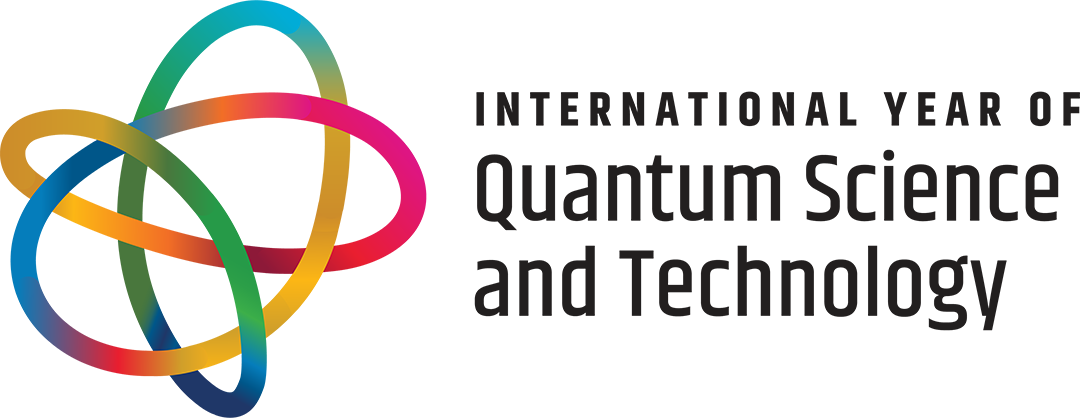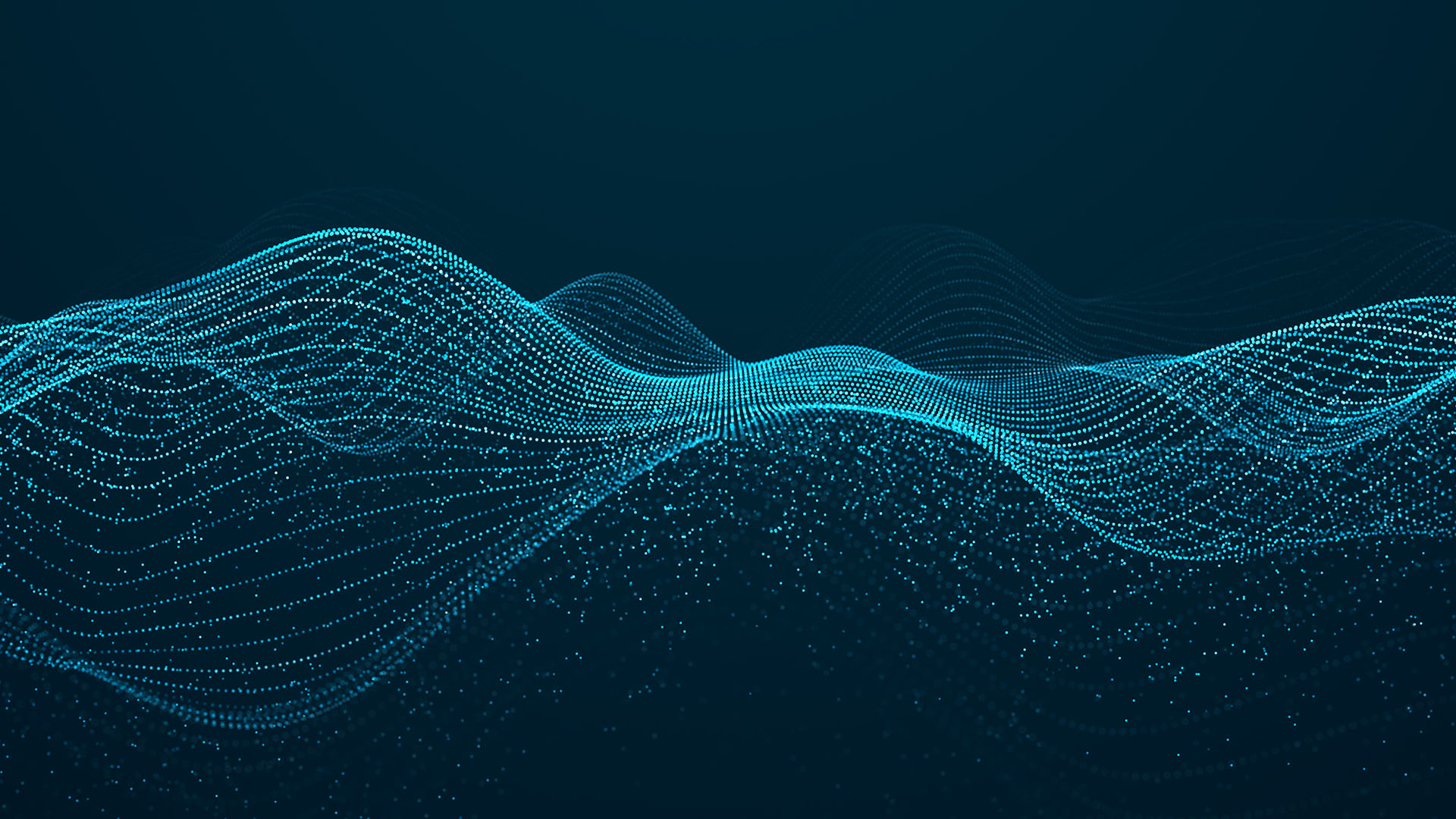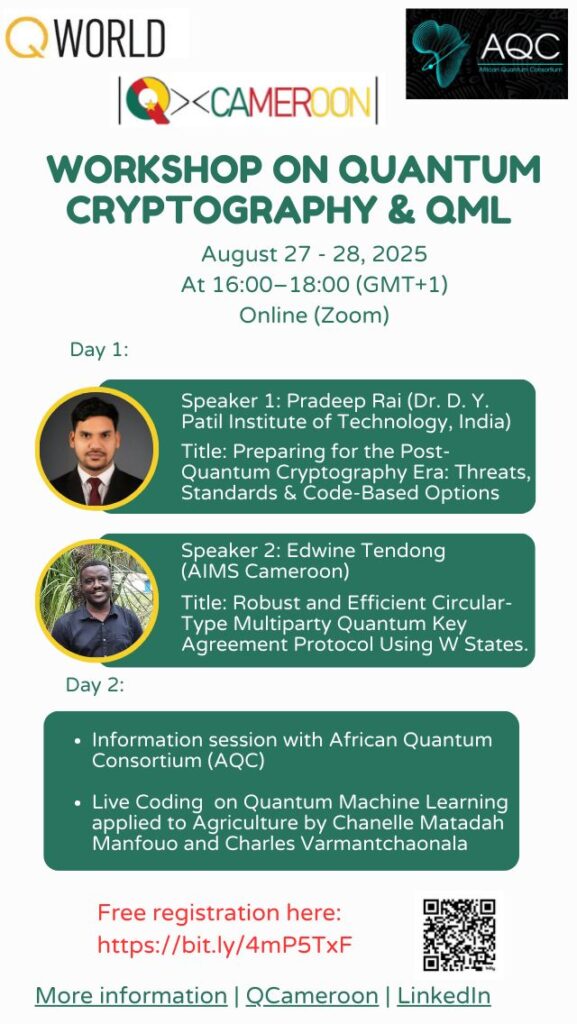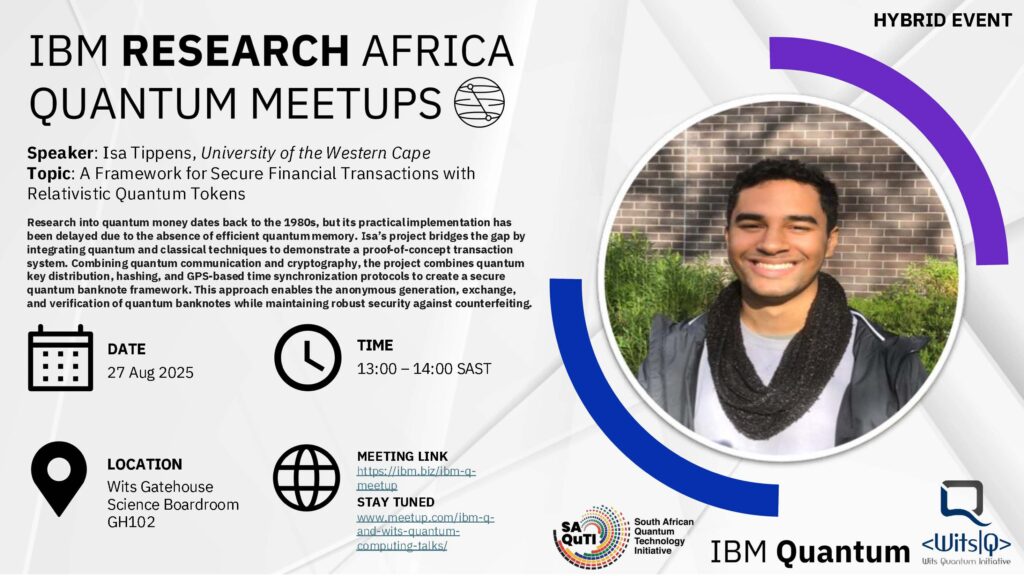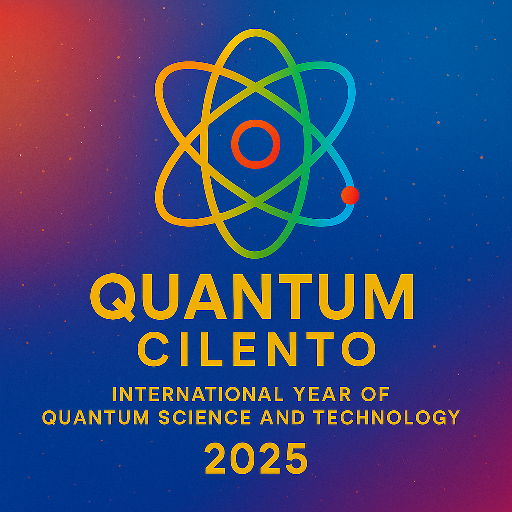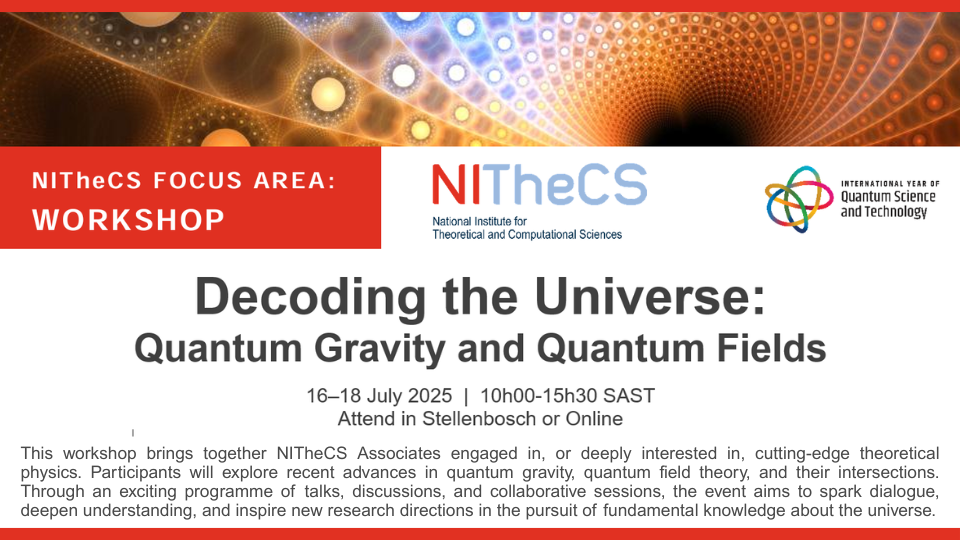This two-day online workshop, organized by QCameroon, will feature invited talks on quantum cryptography and a coding session on quantum machine learning. Day one will feature invited talks on quantum cryptography, while Day two includes a hands-on coding workshop on quantum machine learning for agriculture.
IBM Research Africa Quantum Meetup: A Framework for Secure Financial Transactions with Relativistic Quantum Tokens
We’re excited to welcome Isa Tippens from the University of Western Cape as our featured speaker in this engaging seminar series. The event will be held in a hybrid format, with in-person attendance at Wits, Gatehouse, and online participation available.
Research into quantum money dates back to the 1980s, but its practical implementation has been delayed due to the absence of efficient quantum memory. Isa’s project bridges the gap by integrating quantum and classical techniques to demonstrate a proof-of-concept transaction system. Combining quantum communication and cryptography, the project combines quantum key distribution, hashing, and GPS-based time synchronization protocols to create a secure quantum banknote framework. This approach enables the anonymous generation, exchange, and verification of quantum banknotes while maintaining robust security against counterfeiting.
«BOOT CAMP» on Amaravati Quantum Hackathon 2025
The Amaravati Quantum Valley Hackathon 2025 is a pioneering national initiative designed to unlock student-driven innovation in the rapidly emerging field of quantum technologies. Spearheaded by the Andhra Pradesh State Council of Higher Education (APSCHE), the hackathon will spotlight the Amaravati Quantum Valley as a future-ready hub for deep-tech solutions across critical sectors such as defense, logistics, drug discovery, agriculture, and finance.
This first-of-its-kind event empowers students to tackle real-world challenges sourced from ministries, government departments, PSUs, leading tech giants, and NGOs. With active support from top organizations like DST, IBM, TCS, Google, and Microsoft, the hackathon aims to be a talent magnet and a launchpad for transformative ideas.
Core Objectives
- Channel the creativity of youth toward quantum-powered problem-solving.
- Nurture a vibrant ecosystem of campus-based hackathons and innovation cells.
- Create a strong pipeline for Innovate Andhra Pradesh and the Startup India movement.
- Crowdsource implementable solutions for governance, public service, and industry.
- Encourage disruptive, future-focused thinking to address India’s grand challenges through quantum-enabled applications.
Q3 American Physical Society Community Meetup
The American Physical Society (APS) Austin Meetup on Thursday, September 11, 2025, will feature a panel discussion titled “The Race to Scale: Which Quantum Technologies Will Win Which Applications, and Why?” Experts in quantum hardware will explore the leading platforms in computing, networking, and sensing, as well as the state of quantum error correction for commercial applications.
The event provides an opportunity to gain insights into the future of quantum technologies and their practical implications across various industries. This gathering will bring together academia, industry leaders, and innovators for a discussion on the advancements shaping the quantum landscape. Here is the website, and registration is open:
Symposium – Quantum Science and Technology in Healthcare
The Quantum Science and Technology in Healthcare symposium is part of the 13th National Congress of AIFM (Italian Association of Medical Physics). This symposium is a plenary session of the Congress, scheduled for Saturday, October 18th, from 10:15 am to 11:45 am. We anticipate between 500 and 600 attendees based on current registrations.
The aim of the event is to increase awareness of QST in the Italian medical physics community, highlighting its potential applications in medicine, particularly in the fields of quantum sensing and quantum computing.
Here is the schedule for the symposium, highlighting its connection to quantum science and technology:
Introduction – Celebration of Quantum Science on the IYQ
- Carlo Cavedon – President of AIFM (Italian Association of Medical Physics)
- Oscar Adriani – Member of the INFN Board of Directors (National Institute of Nuclear Physics)
Session 1 – Quantum Sensing in Medical Applications
- Marco Genovese – Director of the Quantum Optics research sector of INRIM (National Institute of Metrology)
- Pietro Faccioli – INFN (National Institute of Nuclear Physics)
Session 2 – Quantum Computing in Medical Applications
- Alberto Quaranta – President of the 5th Scientific Commission of INFN
- Samuele Cavinato – University of Torino and IOV Padova (Veneto Institute of Oncology)
The symposium will cover various topics, including the potential of quantum computing in radiation therapy real-time optimization, quantum sensors for biomedical applications, quantum-enhanced imaging, quantum magnetometers in cardiology, quantum sensors in brain mapping, and quantum computing for predictive models and personalized medicine.
Quantum Computing in Industry
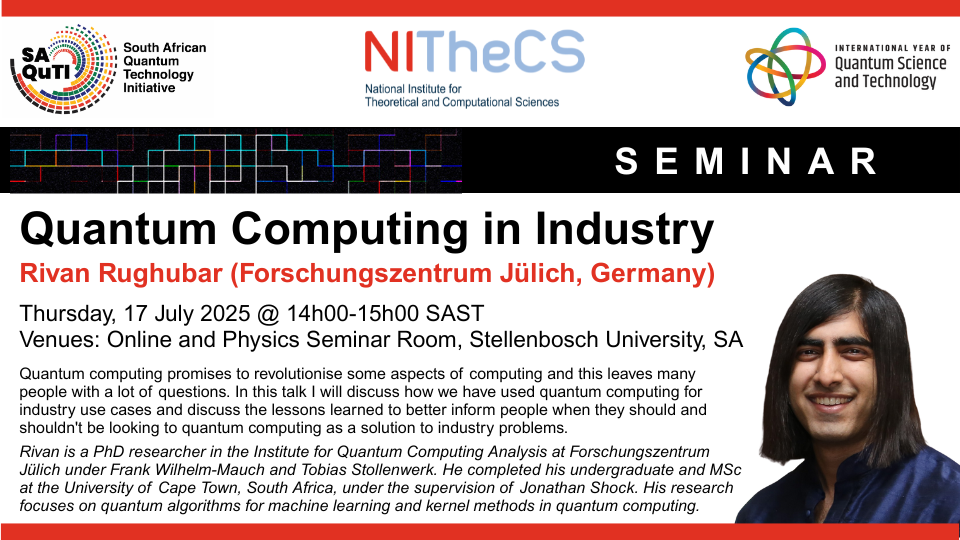
Abstract
Quantum computing promises to revolutionise certain aspects of computing, leaving many people with plenty of questions. In this talk, I will discuss how we have applied quantum computing to industry use cases and share the lessons learned to better inform people when they should and shouldn’t look to quantum computing as a solution to industry problems.
Biography
Rivan is a PhD researcher in the Institute for Quantum Computing Analysis at Forschungszentrum Jülich under Frank Wilhelm-Mauch and Tobias Stollenwerk. He completed his undergraduate and MSc at the University of Cape Town under the supervision of Jonathan Shock. His research focuses on quantum algorithms for machine learning and kernel methods in quantum computing.
Celebration of 100 years of Quantum Mechanics in São Carlos Tribute to the Life and Work of Dan Kleppner
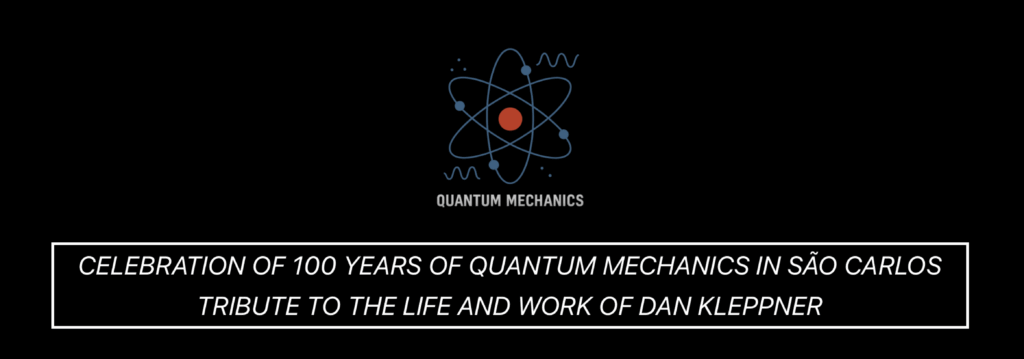
This year, quantum mechanics celebrates its 100th anniversary. Join us at the Physics Institute of São Carlos of the University of São Paulo to celebrate.
We also take the opportunity to celebrate the life and work of our good friend Dan Kleppner, who passed away this year. Dan was one of the founding fathers of modern atomic physics and an inspiration to many generations of scientists working with atoms and light in the realm of quantum mechanics.
Quantum Cilento
In the occasion of the celebrations of the Quantum Year 2025, the Association “ Cilento Domani Arte e Cultura Mediterranea APS” based in the province of Salerno, South Italy, and the Association Scienza e Scuola APS are promoting an event aimed to spread consciousness among students and citizen of the Cilento area, about the enormous achievements in all fields of hard sciences since the Quantum interpretation paradigm has been introduced last century in Physics. The one-day conference will take place at the secondary school Liceo “Alfonso Gatto “ of Agropoli on November 12th. Talks will be given by physicists and chemists lecturing at the Università “Federico II” di Napoli. The goal is to convey the sense of how much the understanding of the quantum nature of our world and ourselves has been leveraged by technology to transform our way of life. The day before, an exhibition of kits showing lasers, LEDs, solar cells, and detectors controlled by information and communication technology will be on display to capture the students’ and visitors’ surprise and their interest, and to prepare them for the conference the next day.
Queer Quest: A Journey to Self-Discovery
Queer Quest invites participants to experience quantum science not only as a discipline—but as a liberatory framework for reimagining identity, healing, and possibility. This immersive two-day event, held in partnership with Center on Halsted and a satellite event to Arlan Hamilton’s Your First Million Live, is curated for LGBTQIA+ Black and Brown professionals working at the intersection of STEAM and mental health.
Queer Quest offers a multidimensional experience where participants
- Reconnect in culturally affirming spaces
- Learn from dynamic keynote speakers
- Explore decolonial frameworks in workshops like “Healing in Oppressive Systems” and “Reclaiming Rest as Resistance”
At the center lies the Mental Health & STEAM Resource Village, where inclusive therapy collectives and hands-on quantum demos anchor a community of care.
Queer Quest is a first-of-its-kind event that makes quantum science radically accessible, emotionally resonant, and culturally grounded—proving that no one owns quantum science, and everyone is invited.
NITheCS Focus Area Workshop: ‘Decoding the Universe: Quantum Gravity and Quantum Fields’
This workshop will bring together NITheCS Associates engaged in, or deeply interested in, cutting-edge theoretical physics. Participants will explore recent advances in quantum gravity, quantum field theory, and their intersections. Through an exciting programme of talks, discussions, and collaborative sessions, the event aims to spark dialogue, deepen understanding, and inspire new research directions in the pursuit of fundamental knowledge about the universe.
